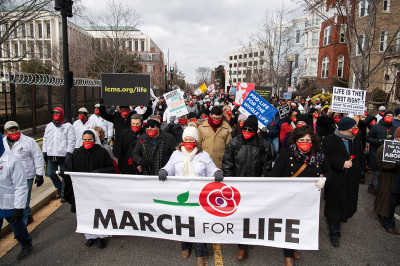This March for Life, we’re marching Roe right out the door

At this year’s March for Life, pro-life advocates have many reasons to be hopeful. More than 500 new pro-life bills were introduced in the U.S. in 2021, and 61 of those bills became law. Now this year, the Supreme Court has the chance to overturn 50 years of unconstitutional abortion precedent with their ruling on Dobbs v. Jackson Women’s Health Organization later this year.
This ruling will determine the future of legal abortions in America. And based on the case’s oral arguments back in December, things are looking up for the pro-life cause. We’ve known since 1973 that Roe v. Wade needs to go, and arguments to the contrary from the justices at the Supreme Court hearing just don’t hold up.
Take Justice Sonia Sotomayor — she said that Roe v. Wade was an important legal precedent to keep because it had created an “entrenched set of expectations” in America: federally-protected access to abortions.
But here’s the thing: “Entrenched expectations” do not justify unconstitutional legal precedent, and they never have. The Supreme Court was never intended to be a direct expression of the will of the people. And what’s more, the Court in Planned Parenthood v. Casey even admitted there will always be disagreement over legal abortion. Tens of thousands of Americans will attend the March for Life this year, refuting the idea that Roe v. Wade is an ironclad legal precedent in the eyes of Americans.
It’s time we put behind us the judicial regime established 50 years ago, no matter how long it has held sway over abortion law, no matter how “entrenched” expectations may be.
The court has clear guidelines for deciding when a previous law or ruling is subject to change or review; a poorly-reasoned decision is not worth defending just because it is precedent. Both Roe and Casey holdings rely on manifestly shoddy logic to manufacture non-existent rights. And not only are they poorly-constructed decisions, but they’re also blatantly unconstitutional.
Stare decisis refers to courts’ deference to previous rulings; it helps prevent arbitrary changes to existing law. But it never was an “inexorable command.” It should not be used to prop up egregious rulings. And both Roe and Casey established a set of legal precedents to which stare decisis simply should not apply.
Moreover, both Roe and Casey are indefensible instances of legislation from the bench. The Roe decision fabricated the constitutional right to abortion using the Fourteenth Amendment, asserting that a “right to privacy” was implied. The Casey decision claimed to support the “essential holdings” of Roe nearly 20 years later, but in fact, created an entirely new shoddy framework for determining the constitutionality of state abortion laws.
This is not jurisprudence, it’s activism. The Supreme Court has generated a series of confusing and nonsensical precedents that cooked up new “rights” and legal assumptions under the pretense of constitutional law.
States need a clear roadmap to craft abortion laws, but their efforts to do so are repeatedly struck down by justices under the Casey legal framework. The court must recognize states’ authority to legislate as they see fit. If they choose to protect the unborn, as Mississippi has done, they should be allowed to do so.
The court has an essential function as interpreter and upholder of constitutional and common law, and it has repeatedly corrected grave legal errors in the past. For instance, in Loving v. Virginia, the court overturned existing law barring interracial marriage. In Brown v. Board of Education, the court established racial segregation as unconstitutional. In none of these cases would it have been morally correct to consider the “expectations” of the time.
With Roe and Casey, the Supreme Court must once again reverse a bad legal precedent. The Dobbs case is a perfect opportunity for our sitting justices to critically re-examine both Roe and Casey, as well as the unconstitutional network of restrictions and rights these decisions established.
“Expectations” aren’t what’s at stake here. The Court’s function as an interpreter and upholder of constitutional and common law is what’s at stake.
It doesn’t matter that the Roe and Casey decisions have been the law of the land for half a century. They were poorly decided and resulted in a vast, confusing complex of unconstitutional law. It’s time for them to go.
Despite Justice Sotomayor’s comments, many Americans refuse to believe Roe should be settled law. They’ve marched by the tens of thousands in the dead of winter every year for 48 years, and they will be back in Washington this week this year with renewed hope.
Timothy Head is the executive director of the Faith and Freedom Coalition.




























